How to identify and deal with thrips on cannabis plants
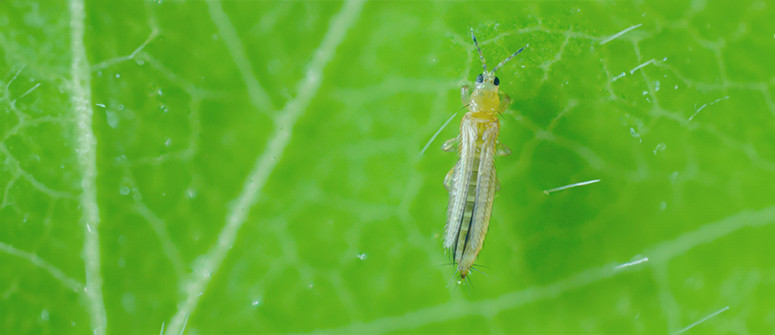
Dealing with a thrips problem? We're here to help. As one of the more threatening cannabis pests, thrips can pose significant danger to a cannabis crop if left untreated. Thankfully, there are plenty of ways to treat a thrips infestation if it occurs, as well as several proven prevention techniques.
Contents:
Growing cannabis, whether indoors or under the blazing sun, can subject your plants to all sorts of pests, pathogens, and fungi. While each of these organisms presents different symptoms and varying degrees of damage, all can reduce the health of your plants and the quality and quantity of your harvest. One particularly vexing pest is thrips—tiny winged creatures that love nothing more than to suck the life out of your plants’ foliage.
In what follows, we’ll arm you with all the information you need to identify the presence of thrips on your weed plants, and, even more importantly, how to eradicate them and prevent them from making a home in the first place.
What exactly are thrips?
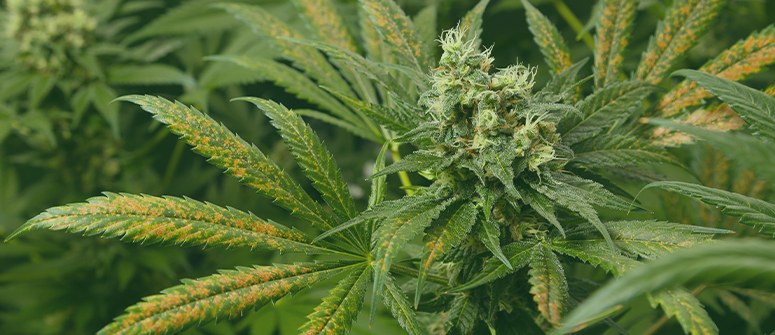
Belonging to the order Thysanoptera, thrips are one of the outdoor cannabis grower’s biggest nemeses. These minute insects are miniscule even at their most mature, making them almost invisible to the naked eye. Though there are well over 7,000 species of thrips, the two most threatening to cannabis plants appear to be onion thrips (Thrips tabaci) and western flower thrips (Frankliniella occidentalis).¹
Beginning life as tiny, pale yellow specimens, thrips eventually develop a light brown exterior and reach a length of around 1.2–1.5mm. Featuring fringed wings, thrips are mediocre in their ability to fly unassisted, and largely move around on the wind. Once they make it onto cannabis plants, thrips are known to use their asymmetrical mouthparts to suck the sap out of cannabis leaf cells, resulting in a wide variety of potential issues. Moreover, thrips can be vectors of disease, and thus are capable of transmitting pathogens to cannabis plants.
The life cycle of thrips is around 2–3 weeks and progresses as follows: egg, two larval instars, pre-pupa and pupal instar, and adult. Unfortunately for cannabis growers, the eggs are laid directly in the plant tissue, which will then develop into mature specimens that feed on the contents of the leaf, particularly on the underside. Moreover, thrips will seek to reproduce constantly, making eradicating them not always a simple affair.
How do thrips get on cannabis plants?
As alluded to, thrips generally find their way onto cannabis plants by riding the wind. Though their wings aren’t particularly adept at flying unassisted, they work just fine to allow mature specimens to drift long distances, from one crop to another. This means that even if thrips don’t appear to be a problem in your garden, one strong gust of wind could bring in pests from many kilometres away. As such, it’s very important to be vigilant about thrips showing up on your plants, especially if you grow outdoors.
That said, thrips can also find their way indoors via contaminated plant material, your shoes or clothes, and through vents or openings in your grow room or greenhouse.
Signs of thrips on cannabis plants
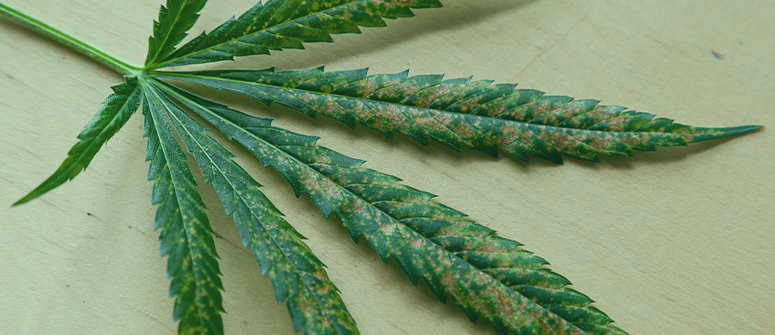
Given their size and method of laying eggs, thrips can be difficult to detect immediately. Unfortunately, once they’ve begun to do serious damage, the health of your plants may be at serious risk.
Below are the main signs and symptoms to keep an eye out for:
- Silvery trails (similar to those left by snails) and black marks (faeces)
- Presence of mature thrips specimens
- A progressed thrips infestation will cause leaves to become brittle and papery
- Stalled growth
How to get rid of thrips on cannabis plants
Eradicating thrips from your cannabis crop is absolutely necessary if you find yourself with an infestation. Allow these pests to continue damaging the leaves, and eventually the growth of your pants will stall and your yields will suffer. Thankfully, there are some tried and tested methods for getting rid of these tiny winged beasts.
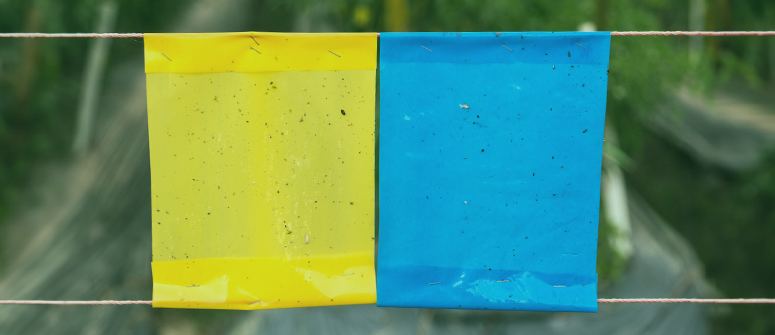
Prune
If your thrips issue is localised to just a couple of leaves, you can simply prune the affected foliage and dispose of it, far away from your grow-op. This tactic, used in concert with one or more of the suggestions below, can help to stop an infestation from progressing any further.
Blue sticky traps
A method of both treatment and prevention, blue sticky traps will attract adult thrips and keep them off of your plants. By themselves, these traps can help you assess the severity of your infestation. However, they are best used alongside other treatment methods to ensure the issue is fully dealt with.
Biological controls
One of the best ways to get rid of thrips without damaging the health of your cannabis plants is to use biological controls or predatory insects. Predatory mites (e.g. Neoseiulus cucumeris, Amblyseius swirskii, and Iphisieus degenerans) are known to be particularly effective at devouring thrips on the aerial parts of cannabis plants. However, they do require certain environmental variables in order to be effective, so do your due diligence before making your selection.
Other predatory insects, such as minute pirate bugs, green lacewings, and ladybugs, can also be effective for dealing with thrips on above-ground portions of the plant.
It is worth noting that thrips pupae move to the soil to develop into the larval stage. In order to deal with soil-dwelling thrips, Stratiolaelaps scimitus mites can be effective, as can parasitic nematodes like Steinernema feltiae.
Many of these bio controls can be sourced online or from your local garden centre, as thrips pose a threat to all kinds of plants, not just cannabis.
Neem oil
Neem oil is one of the cannabis grower’s biggest allies in the fight against all sorts of pests. By spraying a neem oil solution on the leaves (including the undersides), the oil will coat the thrips and suffocate them. Neem oil is believed to be non-toxic to humans and pets, but you must avoid spraying the flowers of cannabis plants, as it will ruin the taste. Neem is also considered a viable prevention technique, as it will keep all sorts of critters from messing with your plants in the first place.
Insecticidal soap
Like with neem oil, you can apply a foliar spray of insecticidal soap to deal with your thrips issue. This will weaken the shells of the thrips, causing them to lose water and die from dehydration. All that’s needed is dishwashing soap and vegetable oil. This method of insect control is much less harsh than commercial pesticides and has a relatively small environmental impact. However, as the effects do not tend to last very long, daily application of insecticidal soap may be necessary until the issue is eradicated.
To increase the effectiveness of your anti-thrips foliar spray, consider combining neem oil and insecticidal soap into one solution.
Diatomaceous earth
To help deal with soil-dwelling stages of the thrips life cycle, diatomaceous earth can be used to destroy the shells and dehydrate thrips on contact. As long as it is administered properly (we recommend using a face mask to avoid inhaling the dust), diatomaceous earth is not toxic to humans or animals.
Spinosad
As a last resort, commercial pesticides can be employed to kill thrips. We don’t recommend using these, however, as they may prove toxic to humans and are not very good for the environment. That said, weekly sprays with natural insecticides like spinosad can help to stop an infestation in its tracks. Just be sure to avoid spraying the flowers.
Important to note is that foliar application of spinosad must be consistent on all parts of the leaves if it's to be effective. This is true for neem oil and insecticidal soap applications as well.
How to prevent thrips on cannabis plants
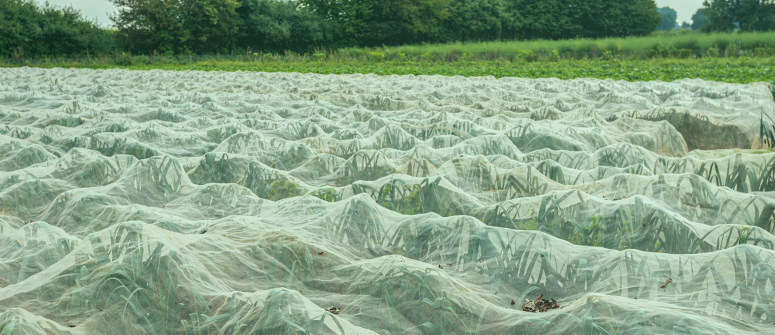
We all know that prevention is better than a cure, especially when it comes to weed-related issues. By arming yourself with the above knowledge about thrips habits, you can better protect your crop.
Blue sticky traps
Returning to our blue sticky trap suggestion, this can be a great first port of call to catch a few errant specimens. While it’s probably not enough to ward off an entire infestation, it can help to prevent your crop from coming under attack.
Fine mesh netting
Row covers with fine mesh netting can keep adult thrips away from your crop, among other pests. While not 100% effective, they form part of a comprehensive thrips prevention protocol. Just make sure the mesh size is fine enough to block out the tiny bodies of thrips.
Reflective mulch
Moreover, silver or grey reflective mulch can act to confuse thrips and keep them from landing your crop. To ensure success, add the mulch before plants sprout so they are guarded on all sides. In lieu of mulch, you can also strategically place reflective plastic to do the same job.
Ensure clean soil and pest-free cuttings
It might go without saying, but it’s essential to start every grow with high-quality soil. Many pests and pathogens can lay dormant in seemingly good soil, only to emerge when conditions are suitable. Moreover, if growing from cuttings, or if you're growing other plants alongside cannabis, ensure these have not been subject to thrips, as they can easily pass an infestation along.
Keep your grow space clean and your plants healthy
Whether you're growing indoors or outdoors, keep your garden or grow space free of any debris that could play host to a thrips population. When growing outside, this also means disposing of any weeds or problematic organic matter.
Finally, by maintaining the overall health of your plants, they will be better equipped to handle a thrift infestation if it does rear its ugly head. This means providing ample light, air circulation, and a rich, appropriate growing medium. Also, always err on the side of underwatering as opposed to overwatering, as the latter is much more likely to lead to issues with pests and pathogens.
Are thrips really that bad for cannabis plants?
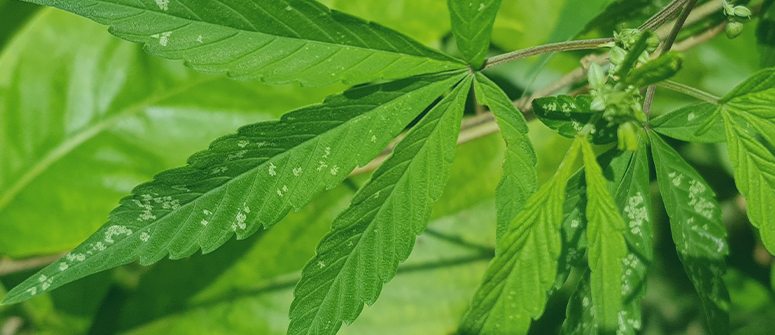
Although the presence of thrips doesn't automatically signify disaster, if left to progress, an infestation can absolutely cause major damage to your pants and their ability to produce high-quality results. As the leaves are the centre of photosynthesis, any issues that prevent them from carrying out this all-important process will result in stalled growth. So, consider the prevention methods mentioned in this article, and employ our treatment techniques to ensure you keep thrips from thwarting your grow.
References:
1. Pest Management of Hemp in Enclosed Production Thrips. Accessed December 6, 2023. https://webdoc.agsci.colostate.edu/hempinsects/PDFs/Thrips%20extra%20info.pdf




